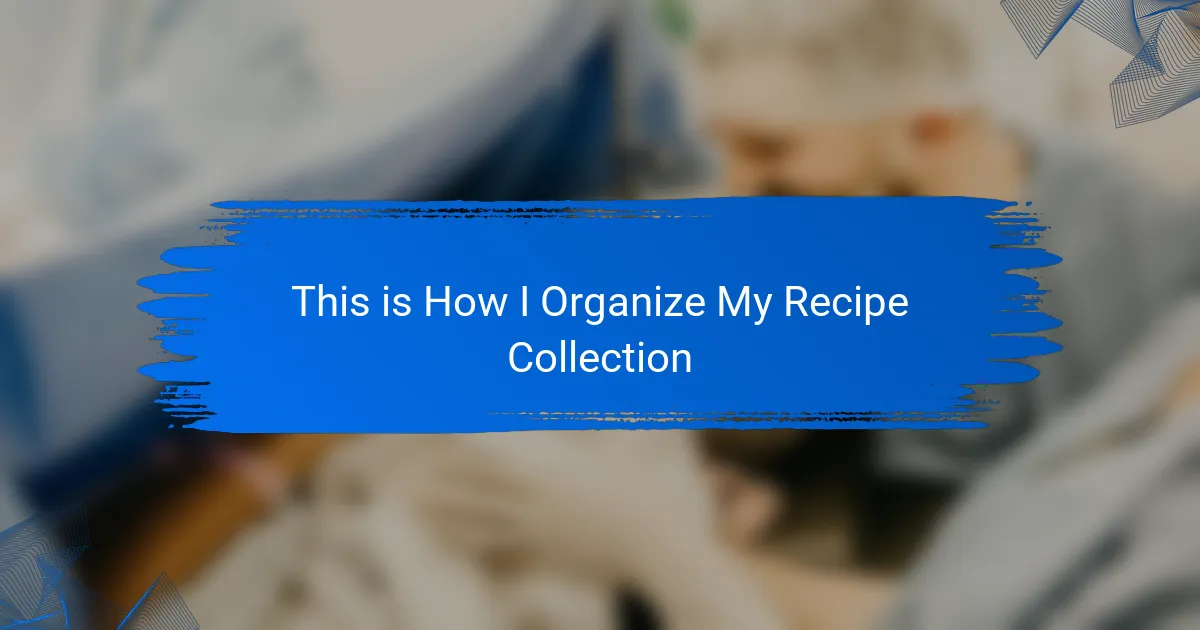Key takeaways
- A recipe collection is a personal archive that reflects memories and emotions associated with cooking and sharing meals.
- Organizing recipes enhances creativity and makes cooking more enjoyable by reducing stress associated with disorganization.
- Choosing the right storage method, whether physical or digital, should align with personal cooking habits and preferences.
- Regular maintenance, including updating and personalizing recipes, keeps a collection fresh and connected to individual cooking experiences.
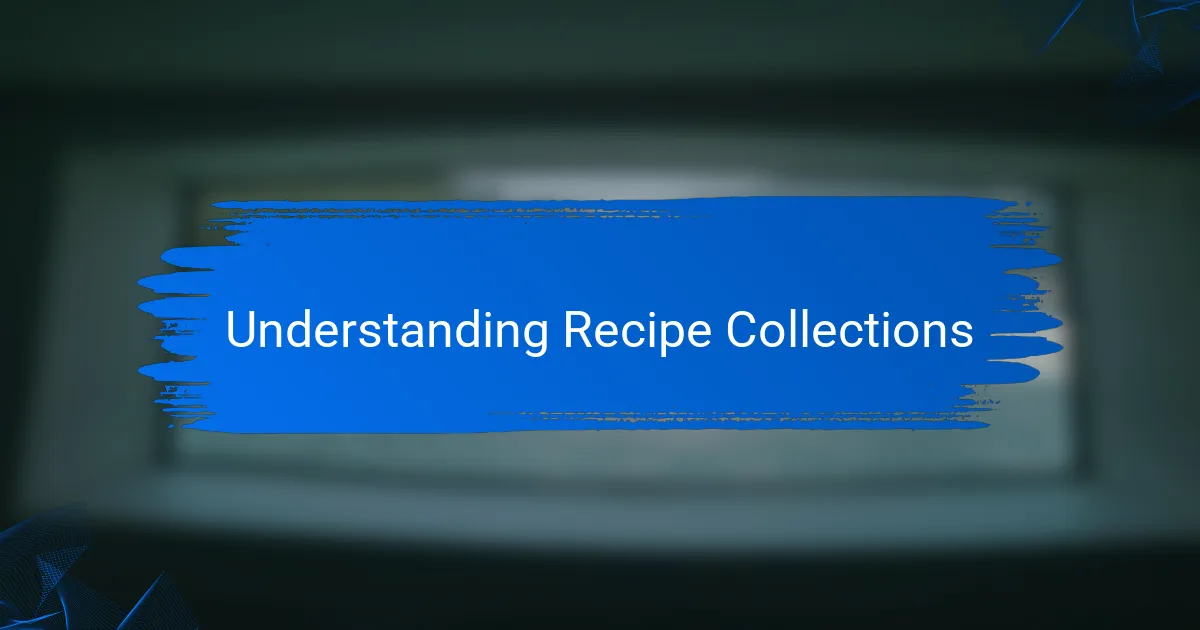
Understanding Recipe Collections
A recipe collection isn’t just a random pile of papers or bookmarked websites; it’s a personal archive of memories, flavors, and moments shared around the table. Have you ever thought about how each recipe tells a story, whether it’s a passed-down family favorite or a new dish you perfected last weekend? For me, understanding this makes organizing recipes feel less like a chore and more like preserving parts of my life.
When I look at my own collection, I see more than just ingredients and instructions—I see the laughter from holiday dinners and the satisfaction of a meal well-made. It’s emotional, in a way, because each recipe holds a special place in my heart. Do you keep your recipes to simply cook, or do they represent something deeper for you too?
Recognizing the sentimental value in a recipe collection influences how I arrange it. It’s not just about efficiency; it’s about honoring the memories those dishes carry. This perspective shapes everything from how I label my folders to the order I choose to keep the recipes, making the process feel much more meaningful than just tidying up.
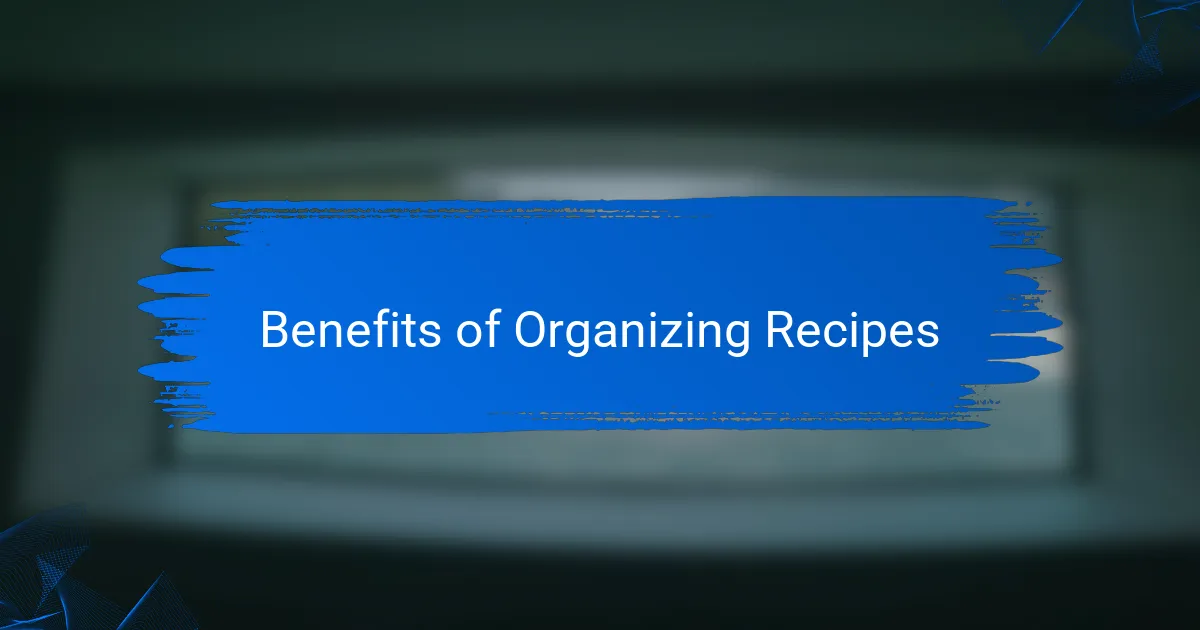
Benefits of Organizing Recipes
There’s a sense of calm that comes with knowing exactly where to find that perfect lasagna recipe or grandma’s cookie formula. For me, organizing recipes eliminates the frustration of hunting through clutter, turning what used to be a stressful search into a moment of pure anticipation for a delicious meal.
I’ve noticed that when my recipes are neatly arranged, cooking becomes less about guessing and more about experimenting. Have you ever felt held back by disorganized notes or missing ingredients? Keeping everything in order frees up mental space to be creative and enjoy the process instead of feeling overwhelmed.
Beyond convenience, organizing my collection helps me pass down tradition in a way that feels intentional and loving. When I share a recipe, it’s not just directions—it’s a piece of history that’s easy to find and cherish. Isn’t that what family life in Cleveland is all about—creating and preserving memories one meal at a time?

Choosing the Right Storage Method
Choosing the right storage method for your recipes is more than just picking a place to stash papers or files; it’s about finding a system that reflects how you cook and remember. I’ve tried everything from recipe boxes to digital apps, and what really matters is matching your storage to your lifestyle—do you prefer flipping through pages or scrolling on your phone while in the kitchen?
For me, the tactile feeling of handwritten cards brings back warm memories, so I keep those in a well-worn box that feels like a family heirloom. But I also use a digital folder for newer recipes, which makes it easy to search and save without the clutter. Have you found a method that feels both practical and personal to you?
There’s something comforting in knowing your recipes are safe, accessible, and arranged in a way that invites you to cook more often. What storage method helps you feel connected to your recipes—not just organized? It’s a question I keep coming back to as my collection grows alongside my family’s stories.
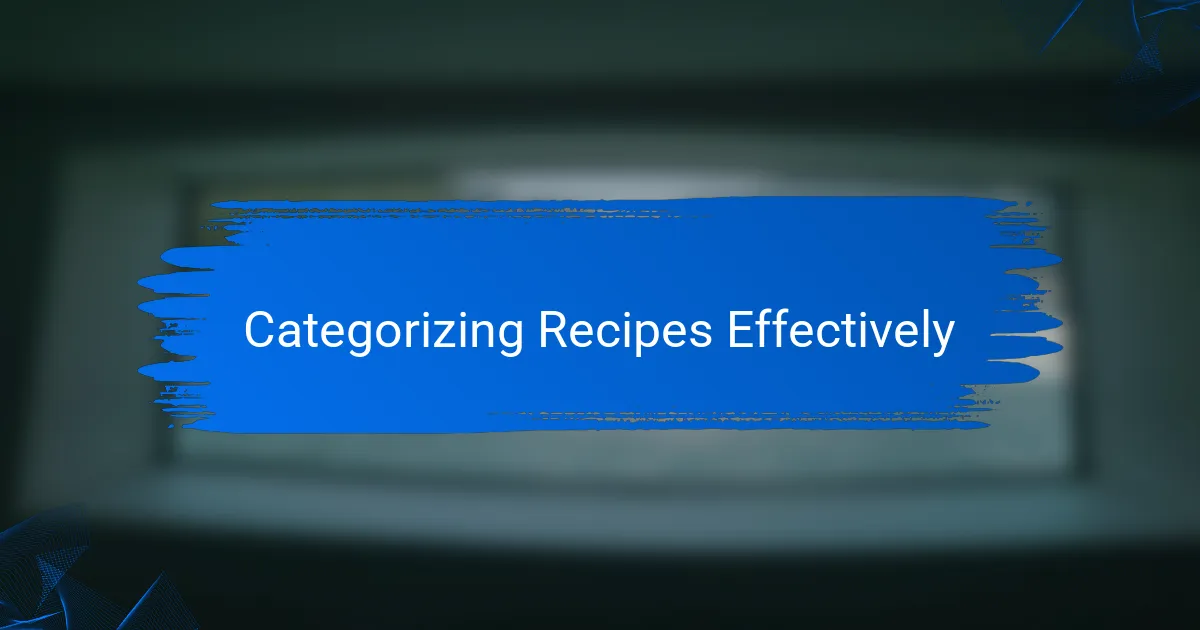
Categorizing Recipes Effectively
Sorting my recipes into clear categories helps me find exactly what I want without second-guessing. I usually divide them by meal type—breakfast, lunch, dinner—and then by main ingredient or cooking method. Have you ever spent too long looking for that one soup recipe only to realize it got mixed with desserts? That’s why I swore off vague groupings in favor of distinct, meaningful categories.
Sometimes I get a bit more detailed, separating family favorites from new experimental dishes. This little step not only speeds up my meal planning but also sparks joy because I immediately know which recipes bring comfort and which invite adventure. When I organize this way, it feels like I’m opening a curated cookbook rather than rifling through chaos.
Another trick I use is color-coding recipe cards or digital folders by category, which adds a visual cue that my brain loves. It’s astonishing how something as simple as a splash of color can turn a cluttered recipe pile into an inviting collection. Have you tried this? I find it makes cooking feel less like work and more like a creative escape.
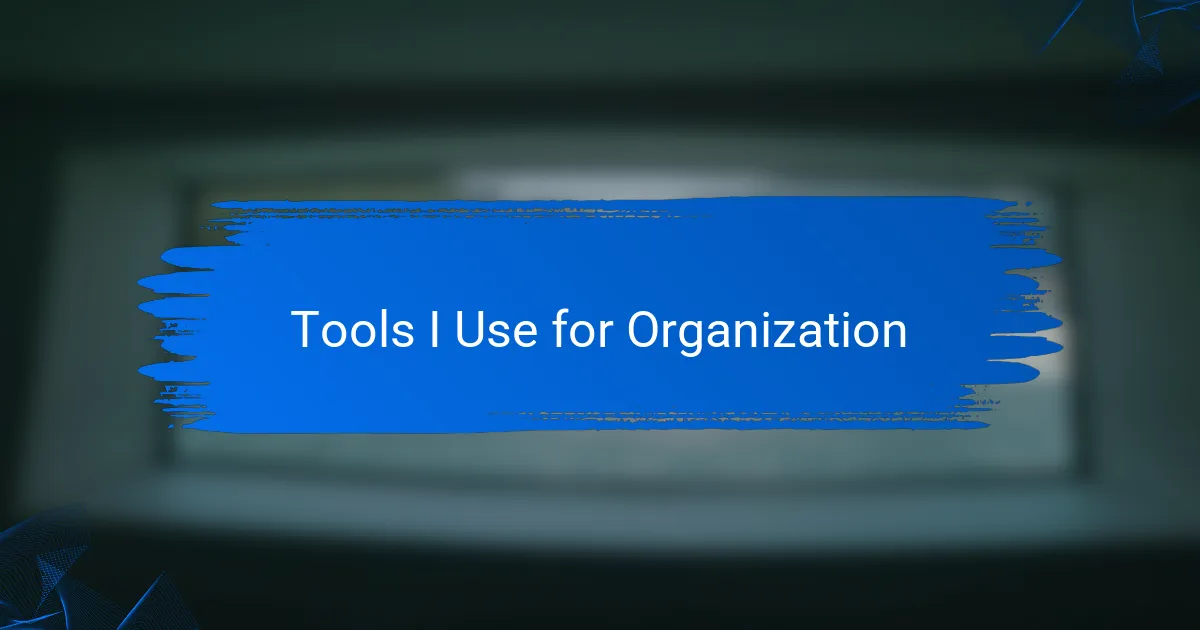
Tools I Use for Organization
When it comes to tools for organizing my recipe collection, I rely heavily on a combination of physical and digital methods. I keep a sturdy recipe binder filled with plastic sleeves where I slip in handwritten or printed recipes—it’s my go-to for quick access when I’m cooking. Have you ever noticed how tangible things, like flipping through pages, somehow make the recipe feel more intimate and real? For me, it’s like holding a piece of family history every time I open that binder.
On the digital front, I use a simple cloud-based app that lets me tag and sort recipes by ingredients or meal type. This digital tool gives me peace of mind knowing my recipes won’t get lost and that I can grab any recipe on my phone when I’m at the grocery store or kitchen counter. The search function alone saves me from endless scrolling, which feels like a small victory every time.
I also keep a small notebook for experimental recipes or quick notes on adjustments I want to remember. Jotting things down immediately after cooking helps me capture those little ideas before they slip away. Have you found that the best ideas come right in the moment, when creativity meets the sizzle on the stove? This notebook is my creative sanctuary, balancing out the structured tools with a bit of spontaneity.
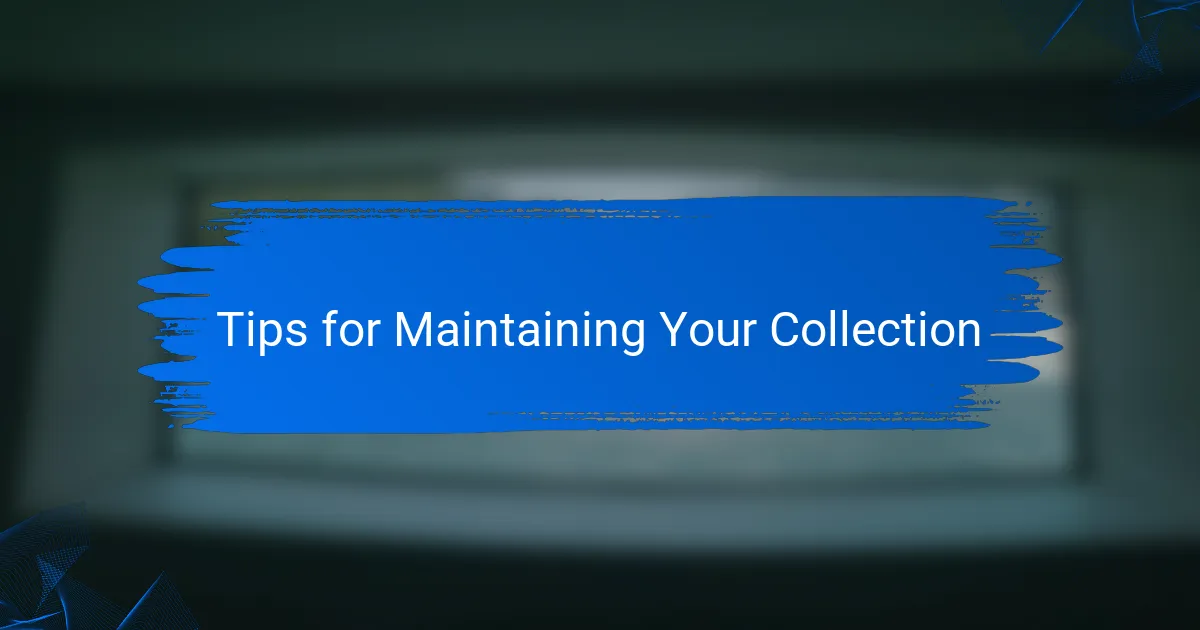
Tips for Maintaining Your Collection
Maintaining my recipe collection feels a lot like nurturing a garden—you have to tend to it regularly or things quickly become unruly. I set aside time every few weeks to weed out recipes I no longer use or to update ones that need tweaking. Do you find that regular maintenance keeps your collection feeling fresh and inspiring rather than overwhelming?
One tip I swear by is keeping a simple index or master list that points to where each recipe lives, whether it’s in a binder, an app, or a folder. It’s saved me so many moments of frustration when I needed to find a recipe quickly for a last-minute dinner invite. Have you ever experienced that panic of rifling through piles or scrolling endlessly, only to come up empty-handed?
Also, I make a habit of adding little notes next to my recipes after trying them—whether it’s a substitution that worked or a timing adjustment. Those small scribbles have become invaluable over time, transforming my collection from static instructions into a living, evolving resource. Have you noticed how personalized tweaks make a recipe feel truly yours? That’s the kind of connection I aim to maintain.
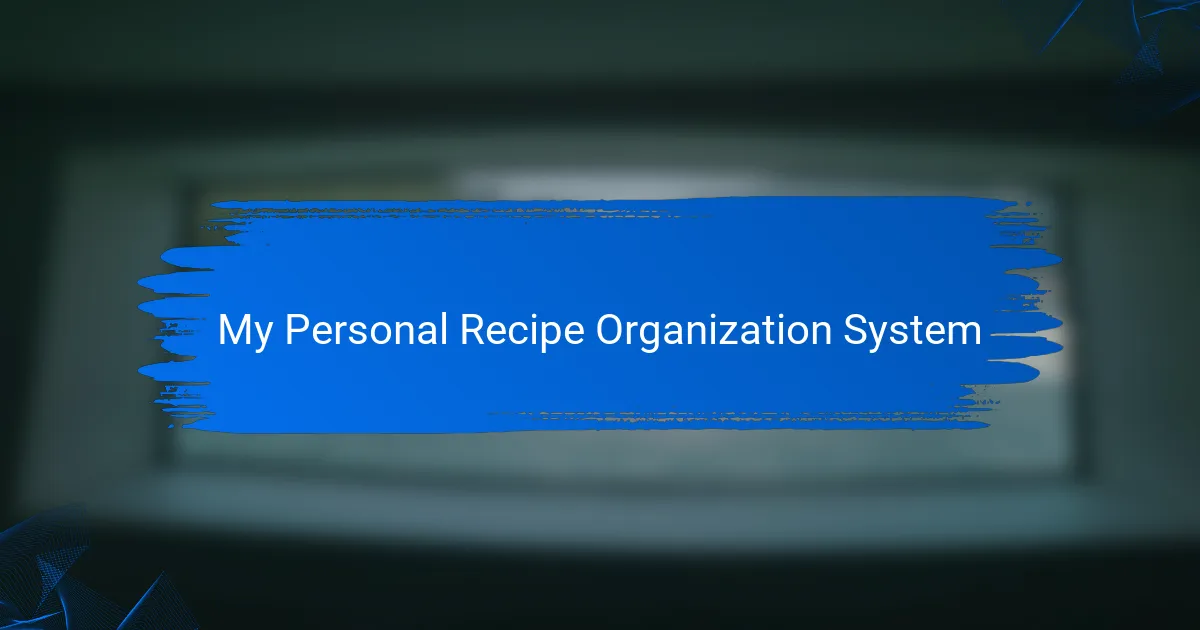
My Personal Recipe Organization System
My recipe organization system is a blend of old-school charm and modern convenience. I cherish my handwritten recipe cards—they carry the warmth of family traditions and the scratchy notes from years of cooking experiments. But I can’t ignore the digital side either; having a searchable folder on my tablet means I’m never scrambling when I need a recipe on the fly.
I arrange my recipes by category, but with a twist that feels personal to me. For example, my “comfort food” section isn’t just about the dish—it’s about the memories attached to each one. When I pull out that folder, I’m not just planning a meal; I’m reconnecting with moments that make cooking feel meaningful and grounding.
I’ve found that keeping a simple index where I jot down where each recipe is stored saves me more time than I ever expected. There have been frantic evenings when that little list was my saving grace—no more tearing apart drawers or endless scrolling. Isn’t that kind of peace exactly what we all want in the kitchen?
